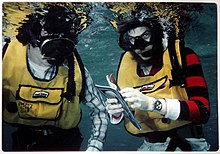Eric Prosh

Eric Charles Prosh, (December 17, 1957 – September 3, 2013) was a Canadian paleontologist, geologist, and civil servant who worked in Nunavut.
Early life
[edit]
Prosh grew up in Roxboro, Quebec. His parents Eric and Marie had immigrated from Europe to Montreal in the early 1950s. He attended Riverdale High School, where he was valedictorian, Vanier College, and Queen's University. He earned a doctorate in paleontology at the University of Western Ontario in 1989, after years of research on fossils in the Disappointment Bay Formation.[1] He was a post-doctoral student at McGill University prior to employment in industry, eventually at Spectral International, a Colorado-based company specializing in remote sensing and spectroscopy.
Legacy
[edit]Prosh joined Nunavut's Department of Economic Development and Transportation in 2006, and became the Director of Minerals and Petroleum Resources.[2] He was a key player on the Nunavut Mining Symposium organizing committees, during a period of strong growth in the regional economy, driven by the mining sector.[3][4] He died suddenly on September 3, 2013 en route back to Iqaluit after a holiday.
One of the annual Nunavut Mining Awards sponsored by Canadian North Airlines is named after him. The Eric Prosh Government/Organization Award is in recognition of the contribution of a government department or organization to the advancement of the mining industry in Nunavut.[5]
External links
[edit]- Legislative Assembly of Nunavut, Hansard, page 4860
- Northern Mining News, Aug 2013 - page 13
- A Mining "Whopper" - Winnipeg Free Press
References
[edit]- ^ Prosh, Eric (January 1989). "A Lower Devonian Reef Sequence and Fauna, Disappointment Bay Formation, Canadian Arctic Islands". Digitized Theses.
- ^ "NunatsiaqOnline 2010-07-19: NEWS: A flicker of hope for Nunavut's mothballed diamond mine". Archived from the original on 2016-03-04. Retrieved 2020-05-24.
- ^ http://www.miningnorth.com/_rsc/site-content/Chamber-news-releases/ChamberCongratulatesNMSMiningAwardWinnersApril2014.pdf [bare URL PDF]
- ^ "Mining expected to drive continued economic growth across North | CBC News".
- ^ "Awards".
